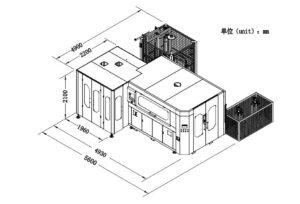The Bed Core Production Line is a complex and well – organized system that transforms raw materials into high – quality bed cores, which are the fundamental components for ensuring a comfortable sleep experience. Here is a detailed look at its workflow:
Raw Material Preparation
For Foam – based Bed Cores:High – density polyurethane foams are selected as the main material. These foams are sourced from trustworthy suppliers and then subjected to strict quality inspections. The received large – block raw foam materials need to be cut into appropriate sizes for subsequent processing steps.
For Innerspring Bed Cores:High – carbon steel wires serve as the primary raw material. These wires first go through a straightening process to eliminate any bends or kinks. Then, they are coiled and formed into individual springs using specialized wire – forming machines. This shaping process requires precision to ensure each spring has the correct shape and strength.
Foam Cutting and Shaping (if foam – based bed cores)
Cutting Techniques:Precision foam cutting machines are utilized. Hot – wire cutting is a common method where an electrically heated wire is passed through the foam. The heat from the wire melts the foam along its path, allowing for efficient cutting of large sheets of foam into specific thicknesses. Another technique is water – jet cutting, which uses a high – pressure stream of water mixed with abrasive particles. This method enables the creation of complex shapes in the foam, which is especially useful for contoured bed cores that offer enhanced support and comfort.
Spring Assembly (for Innerspring Bed Cores)
Forming Spring Units:Individual springs are first arranged into rows. Then, they are interconnected using metal clips or wires to form a spring unit. There are different types of spring units. Pocket springs, for example, are individually wrapped in fabric pockets, which provides better motion isolation. Open – coil springs are connected in a more traditional grid – like pattern, offering a different level of support and durability. The choice of spring unit depends on the desired characteristics of the final bed core.
Assembly and Bonding
Hybrid Bed Cores:In the case of hybrid bed cores that combine foam and springs, the foam layers are carefully placed on top of the spring unit. To hold these components together, either adhesives or mechanical fasteners are used. High – strength adhesives are often preferred as they can create a strong and long – lasting bond between the foam and the spring unit. Some production lines employ automated bonding machines that can precisely apply the adhesive, ensuring consistent quality across all products.
Finishing and Quality Control
Inspection for Defects:Bed cores are thoroughly inspected for any visible defects. This includes checking for uneven surfaces, misaligned springs (in innerspring bed cores), or improper bonding. Pressure – testing machines are used to assess the durability and support of the bed core. For foam – based bed cores, compression tests are carried out to ensure the foam can maintain its shape and support during regular use.
Packaging:Once the bed cores pass the quality control checks, they are wrapped in protective covers or fabric casings. This not only protects the bed core during transportation but also gives it a finished look. After packaging, the bed cores are ready to be distributed to furniture manufacturers or directly to the market.

